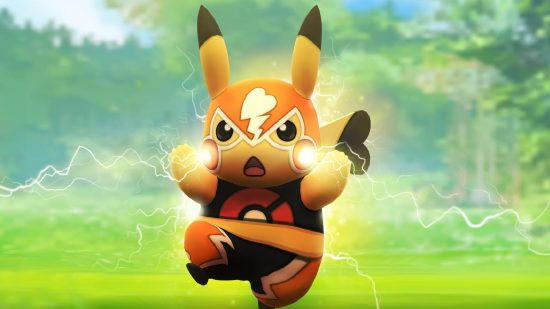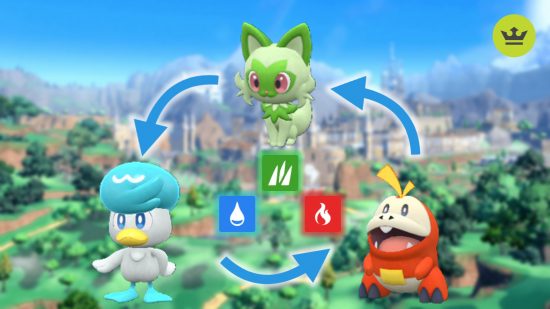Knowing the Pokémon type chart is what separates a good trainer from the best trainer – like comparing Youngster Joey and his top-percentage Rattata to Red sitting up there atop Mt. Silver. Whether you’re new to the series or want to double-check something in an important battle, we’ve got you covered.
After all, memorizing more than 1,000 Pokémon’s weaknesses and resistances is a tough task – even for seasoned veterans of Game Freak’s RPG game series – so it’s always worth checking back to be sure your team is in good shape before you grab your best Switch controller and head off to battle.
Whether you are piloting one of the best Pokémon in Pokémon GO, taking on Alpha Pokémon in Legends Arceus, or curious about some of the type matchups for the best Pokémon Scarlet and best Pokémon Violet teams, knowing the Pokémon type chart is one of the biggest factors in winning or losing. It’s especially important in Scarlet and Violet, thanks to the game’s Tera Type mechanic, which can allow Pokémon to change type mid-battle or in Tera Raids. Here’s everything you need to know, including complete type charts for main series games and Pokémon GO.
Pokémon type chart
Below you can find the full Pokémon type chart, which is accurate for all current main series Pokémon games, including Pokémon Scarlet and Violet and Legends Arceus. The first two columns show how effective a Pokémon type is when attacking, and the last two columns show how strong it is defensively.
Here is the Pokémon type chart:
| Type | Super effective against | Not very effective against | Resistant to | Weak to |
| Normal | – | Rock, Steel, Ghost (no effect) | Ghost (no effect) | Fighting |
| Fighting | Normal, Rock, Steel, Ice, Dark | Flying, Poison, Bug, Psychic, Fairy, Ghost (no effect) | Rock, Bug, Dark | Flying, Psychic, Fairy |
| Flying | Fighting, Bug, Grass | Rock, Steel, Electric | Fighting, Bug, Grass, Ground (no effect) | Rock, Electric, Ice |
| Poison | Grass, Fairy | Poison, Ground, Rock, Ghost, Steel (no effect) | Fighting, Poison, Grass, Fairy | Ground, Psychic |
| Ground | Poison, Rock, Steel, Fire, Electric | Bug, Grass, Flying (no effect) | Poison, Rock, Electric (no effect) | Water, Grass, Ice |
| Rock | Flying, Bug, Fire, Ice | Fighting, Ground, Steel | Normal, Flying, Poison, Fire | Fighting, Ground, Steel, Water, Grass |
| Bug | Grass, Psychic, Dark | Fighting, Flying, Poison, Ghost, Steel, Fire, Fairy | Fighting, Ground, Grass | Flying, Rock, Fire |
| Ghost | Ghost, Psychic | Normal (no effect), Dark | Poison, Bug, Normal (no effect), Fighting (no effect) | Ghost, Dark |
| Steel | Rock, Ice, Fairy | Steel, Fire, Water, Electric | Normal, Flying, Rock, Bug, Steel, Grass, Psychic, Ice, Dragon, Fairy, Poison (no effect) | Fighting, Ground, Fire |
| Fire | Bug, Steel, Grass, Ice | Rock, Fire, Water, Dragon | Bug, Steel, Fire, Grass, Ice | Ground, Rock, Water |
| Water | Ground, Rock, Fire | Water, Grass, Dragon | Steel, Fire, Water, Ice | Grass, Electric |
| Grass | Ground, Rock, Water | Flying, Poison, Bug, Steel, Fire, Grass, Dragon | Ground, Water, Grass, Electric | Flying, Poison, Bug, Fire, Ice |
| Electric | Flying, Water | Grass, Electric, Dragon, Ground (no effect) | Flying, Steel, Electric | Ground |
| Psychic | Fighting, Poison | Steel, Psychic, Dark (no effect) | Fighting, Psychic | Bug, Ghost, Dark |
| Ice | Flying, Ground, Grass, Dragon | Steel, Fire, Water, Ice | Ice | Fighting, Rock, Steel, Fire |
| Dragon | Dragon | Steel, Fairy (no effect) | Fire, Water, Grass, Electric | Ice, Dragon, Fairy |
| Dark | Ghost, Psychic | Fighting, Dark, Fairy | Ghost, Dark, Psychic (no effect) | Fighting, Bug, Fairy |
| Fairy | Fighting, Dragon, Dark | Poison, Steel, Fire | Fighting, Bug, Dark, Dragon (no effect) | Poison, Steel |
These are the general rules of the Pokémon type chart in main series games such as Scarlet and Violet. Super effective attacks – these are attacks against types you’re strong against – deal 2x damage, while not very effective attacks – against types you’re weak against – deal 0.5x damage.
If you happen to be hitting a dual-type Pokémon – more on that below – that is doubly weak to your attack, you’ll deal a devastating 4x damage. For example, Steel and Grass are both weak to Fire, so a Fire-type attack against a Steel/Grass-type Pokémon such as Ferrothorn would deal 4x damage.
Some types are also immune to certain other types – for example, Ghost-type Pokémon like Gimmighoul are immune to Normal and Fighting attacks. Attacks against immune Pokémon will show up in-game as having ‘no effect’, will deal zero damage, and will use up your turn.
This type chart is a super-handy resource and should give you a solid baseline understanding of how strong certain types are against others. However, there are a few other things you need to know and take into consideration.
Dual-types
As you can see, a traditional Pokémon type chart doesn’t include dual types – if it did, it would be rather long! So, here’s what you need to know to help you work out dual-type strengths and weaknesses on the fly.
As mentioned earlier with the example of a Fire-type attack on the Grass/Steel-type Ferrothorn, if a move is super effective against both of the types a dual-type Pokémon possesses, it will deal 4x damage.
If a move is not very effective against both of the types on a dual-type Pokémon, it will deal 0.25x damage. For example, a Fire-type attack against a Water/Dragon-type like Palkia would only do 0.25 of its usual damage, as Fire is weak to both Water and Dragon.
If a move is strong against one type, but not the other, they will balance each other out and you will deal the usual damage output of that move. For example, if you use a Fire-type attack against a Water/Ice-type Pokémon such as Lapras, you will inflict the standard amount of damage for that move, as Fire is weak against Water but strong against Ice.
STAB
Another thing to note is the Same-Type Attack Bonus, or STAB. This essentially rewards you for using an attack that has the same type as the Pokémon using it, giving it a 1.5x damage boost that stacks with any super-effective boosts. So, if the Electric-type Pikachu uses the Electric-type move Thunderbolt, it will get that 1.5x boost for that attack.
STAB is an even more important thing to consider in Scarlet and Violet, thanks to the new Terastalize mechanic which can change the typing of your Pokémon. For example, if you have a Pikachu with the Dragon Tera Type and decide to Terastalize it, it will switch from being an Electric-type to a Dragon-type. This means any Dragon moves it may know will now benefit from STAB, as well as its Electric moves.
So, that’s a full rundown of how the type chart and damage multipliers work in main series games like Scarlet and Violet, but things are a little bit different in Pokémon GO on mobile.
Pokémon types explained
Here are the 18 Pokémon types:
- Grass
- Fire
- Water
- Electric
- Flying
- Normal
- Ground
- Rock
- Psychic
- Bug
- Poison
- Fighting
- Ice
- Ghost
- Dark
- Steel
- Dragon
- Fairy
A Pokémon’s type dictates whether it is stronger or weaker than other Pokémon. If you have a type advantage, you’ll deal ‘super effective’ damage, and if you’re weaker, you’ll do ‘not very effective’ damage. In some situations, your attack could have no effect whatsoever, so it’s important to get to grips with the 18 Pokémon types to maximize your damage output.
The easiest way to begin is with the three starting types you encounter in every main Pokémon game: Fire, Grass, and Water. Fire is super effective on Grass, Grass is super effective on Water, and Water is super effective on Fire. So in the case of Scarlet and Violet, Fuecoco beats Sprigatito, Sprigatito beats Quaxly, and Quaxly beats Fuecoco. It’s just the Pokémon version of the Circle of Life.
However, not every Pokémon has just one type. There are plenty of ‘mons in the Pokédex that have dual-typings. Charizard, for example, is a Fire/Flying-type (though it’s part Dragon in our hearts). That makes working out type effectiveness a little trickier, but we’ll go through all of that with you further on in this guide.
There are also special mechanics that can alter a Pokémon’s type, so be wary. For example, Kecleon’s ‘Color Change’ ability changes its type to that of the last attack it was hit by. Meanwhile, Pokémon Scarlet and Violet introduced ‘Terastallizing’, which is a mechanic that allows a Pokémon to swap its type in Tera Raids and even in the middle of battles against other trainers.
As you can see, knowing a Pokémon’s type and understanding how it matches up against opponents is crucial.
 Pokémon GO type chart
Pokémon GO type chart
The Pokémon GO type chart is largely similar to the main series one, but with some slight differences:
- Super effective moves do 1.6x damage rather than 2x
- Not very effective moves do 0.625x damage rather than 0.5x
- If a Pokémon would usually be immune to a certain of damage (for instance, a Ghost-type being hit with a Normal move), it will instead do 0.39x damage. This is also true if a move would also be super effective, so Charizard would only take 0.39x damage from the Ground-type move Earthquake because it is a Flying-type, despite also being a Fire-type
- If a Pokémon is doubly weak to a move (for example, a Grass/Steel-type Pokémon being hit with a Fire-type move), it will do 2.56x damage in Pokémon GO rather than 4x

Other than that, the Pokémon GO type chart remains the same as the main series chart above. So, whether you’re headed to do a raid or diving into Pokémon GO ranked battles in the GBL, remember to line up Pokémon that deal super effective damage.
How to check a Pokémon’s types
In main series games like Scarlet and Violet, the best way to check a Pokémon’s type is by looking at their Pokédex entry, or by previewing the Pokémon in your party or in a storage box.
A Pokémon’s main types will be shown first in rounded, color-coded bars. Their Tera Type (if they have one) will be shown to the right of its main types in a bar stylized to look like a crystal.
If a Pokémon Terrastalizes during a battle or Tera Raid, you’ll also be able to tell their Tera Type from the crystal ornament that will crown their head. Each type has a different, distinct design. For example, a Pokémon that has activated the Flying Tera Type will have a crown of balloons on its head, while an Electric Tera Type Pokémon will be adorned with a lightbulb. You can see all the Tera Type crowns for all 18 types in the video below.

During the battle, a Pokémon’s type won’t be visible – however, if you’ve battled or caught that Pokémon before, the game will let you know if your moves are going to be super effective or not very effective against it, which is super handy to look out for when picking an attack. Note that these prompts won’t appear if you are battling a species of Pokémon for the first time, as you will not have any data on it.
Equally, if you’re in a high-stakes battle against a new Pokémon and you really need to know its type, there are plenty of online Pokédexes and resources – such as Serebii – where you can find out a Pokémon’s type. Is that cheating? A little bit, but we won’t tell.
What is the best Pokémon type?
The best Pokémon type is Steel, and for good reason. While they are weak to Fighting, Fire, and Ground-types, they resist a whopping 10 different types, and are entirely immune to Poison-types. On top of their innate tankiness, Steel-types can be a nightmare to take down.
When it comes to offensive capabilities, Steel also performs well. It’s super effective against Rock and Ice-types, but performs poorly against Electric, Fire, Water, and other Steel-types. Fortunately, there isn’t a type Steel has no effect on.
The final factor that we’d consider Steel to be the best Pokémon type is undoubtedly a subjective one – it has some of the coolest ‘mon you can get. Be it Gen 2’s Steelix, Gen 3’s Metagross, or Gen 4’s Empoleon and Dialga, there’s no coincidence that Pokémon with Steel typing involved are some of the most metal in the series.
Will there be any new Pokémon types?
There is a chance that the Pokémon series could introduce new types in future games or expansions, however, this is a very rare occurrence and we’d be surprised if any more were added, given how balanced the current 18-type battling system is.
Only three new types have been added since the series launched in 1996. Two new types – Steel and Dark – were added in Generation 2 (Pokémon Gold and Silver), and the last type to be added to the series was Fairy, which debuted in Pokémon X and Y way back in 2013.
Over the years there have been plenty of fan concepts for new types, such as a Sound type for noise-based Pokémon like Jigglypuff and Exploud, or a Space type for celestial beings like Deoxys and Elgyem. However, there have been no recent or notable leaks, rumors, or teases to suggest a new Pokémon type is arriving any time soon.
And that’s our complete rundown of Pokémon types and the Pokémon type chart. Now you’re almost fully prepared for whichever journey you choose to embark on next, be it taking on the Pokémon Scarlet and Violet gym leaders, or even some of the other best free Pokémon games on Switch and mobile. Good luck out there, trainer.


